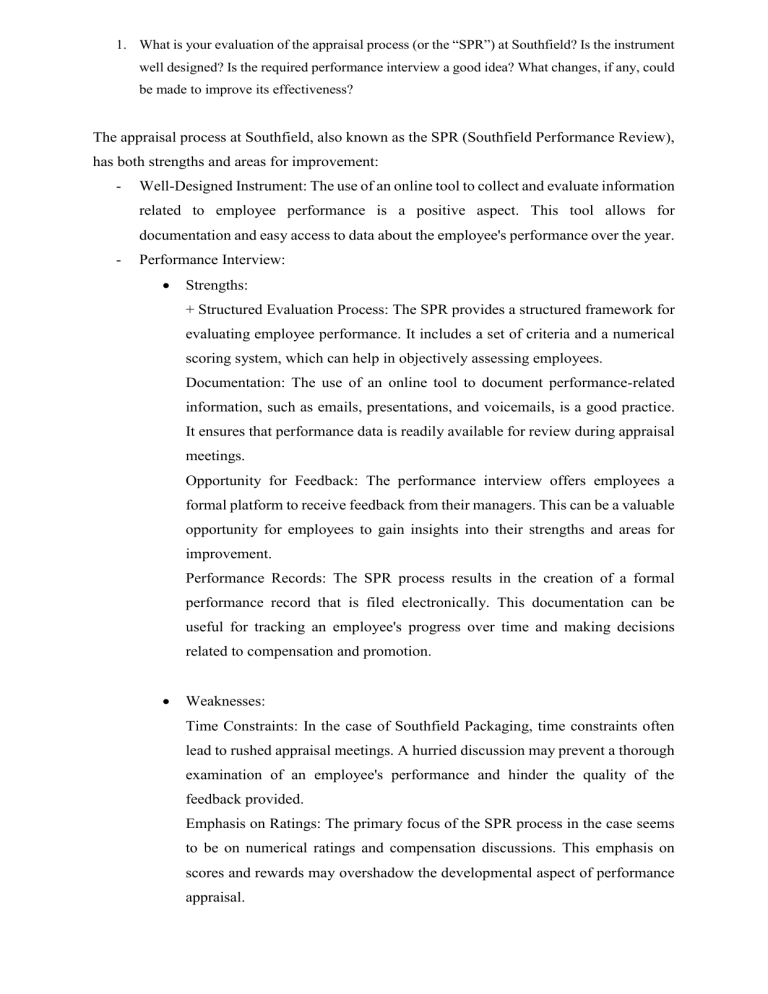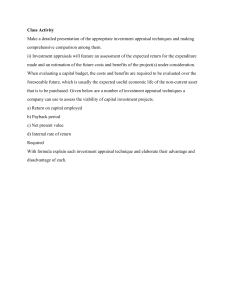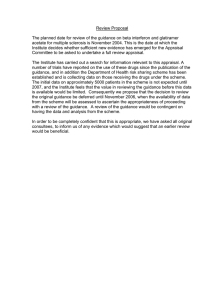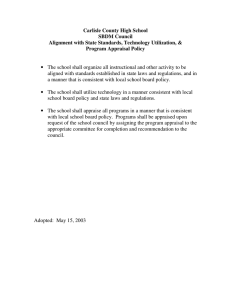
1. What is your evaluation of the appraisal process (or the “SPR”) at Southfield? Is the instrument well designed? Is the required performance interview a good idea? What changes, if any, could be made to improve its effectiveness? The appraisal process at Southfield, also known as the SPR (Southfield Performance Review), has both strengths and areas for improvement: - Well-Designed Instrument: The use of an online tool to collect and evaluate information related to employee performance is a positive aspect. This tool allows for documentation and easy access to data about the employee's performance over the year. - Performance Interview: Strengths: + Structured Evaluation Process: The SPR provides a structured framework for evaluating employee performance. It includes a set of criteria and a numerical scoring system, which can help in objectively assessing employees. Documentation: The use of an online tool to document performance-related information, such as emails, presentations, and voicemails, is a good practice. It ensures that performance data is readily available for review during appraisal meetings. Opportunity for Feedback: The performance interview offers employees a formal platform to receive feedback from their managers. This can be a valuable opportunity for employees to gain insights into their strengths and areas for improvement. Performance Records: The SPR process results in the creation of a formal performance record that is filed electronically. This documentation can be useful for tracking an employee's progress over time and making decisions related to compensation and promotion. Weaknesses: Time Constraints: In the case of Southfield Packaging, time constraints often lead to rushed appraisal meetings. A hurried discussion may prevent a thorough examination of an employee's performance and hinder the quality of the feedback provided. Emphasis on Ratings: The primary focus of the SPR process in the case seems to be on numerical ratings and compensation discussions. This emphasis on scores and rewards may overshadow the developmental aspect of performance appraisal. Inadequate Development Focus: The case does not emphasize the incorporation of a strong developmental component in the performance interview. A wellrounded appraisal process should place a significant emphasis on employee growth, skill enhancement, and goal setting for the future. Limited Two-way Communication: In some instances, the case suggests that the employee's role in the performance interview is largely passive, with managers doing most of the talking. A more interactive and two-way communication process would be more effective in addressing employee concerns and career goals. Perceived Redundancy: The case highlights that some managers find the appraisal process redundant. This indicates a lack of engagement or belief in the effectiveness of the process, which can be demotivating for employees. there appear to be some weaknesses in Southfield Packaging's performance appraisal process: 1. Rushed Appraisal Meetings: The case illustrates that Sanders had to rush through Belby's performance appraisal due to time constraints. Rushed appraisal meetings can lead to important points being missed and hinder effective communication between managers and employees. 2. Limited Feedback and Development Discussion: The case suggests that the performance appraisal meetings are primarily focused on ratings and compensation discussions. There seems to be limited emphasis on developmental feedback and goalsetting for the future. A more comprehensive approach to performance discussions could be beneficial for employee growth and development. 3. Perceived Redundancy: As mentioned earlier, some managers, including Sanders, perceive the appraisal process as redundant. This suggests that there may be a lack of engagement or belief in the effectiveness of the process. The appraisal process should ideally be viewed as a valuable tool for performance improvement. 4. Inconsistency in Rating Criteria: While the case mentions that managers use an online tool to evaluate employee performance, it doesn't provide details about the specific criteria used for evaluation. Inconsistent or unclear rating criteria can lead to inconsistencies in performance evaluations. 5. Lack of Two-way Communication: Effective performance appraisals should involve a two-way communication process. It appears that in the case of Belby's appraisal, Sanders did most of the talking, and Belby had limited opportunity to share his perspective and ask questions. 6. Absence of a Formal Development Plan: The case does not mention the existence of formal development plans or strategies for employees based on their performance appraisals. A structured development plan is crucial for helping employees address their weaknesses and build on their strengths. 7. Wellness and Health Considerations: The case raises the issue of Belby's physical health and personal habits playing a role in his performance appraisal. While health and wellness are important, their direct inclusion in a performance appraisal may be seen as intrusive or subjective. To improve the appraisal process, Southfield Packaging could consider the following: Conducting more in-depth performance discussions that focus on employee development and goal-setting. Ensuring consistency in rating criteria and providing clear guidelines for managers. Promoting two-way communication during appraisals, allowing employees to share their perspectives and concerns. Implementing a formal development plan for each employee based on their appraisal results. Revising the appraisal schedule to allow for sufficient time and attention during meetings. Reevaluating the role of personal health and lifestyle factors in performance appraisals to ensure they are applied fairly and objectively. 2. What is your assessment of Belby’s definition of performance? Belby clearly wants to be promoted in the coming year. Will he reach his goal? Why or why not? Assessment of Belby's Definition of Performance and Promotion Prospects: Frank Belby's definition of performance seems to center around his strong client relationships, dedication to client retention, and his track record in the Midwest region. He has expressed a desire to be promoted in the coming year, and his prospects for achieving this goal depend on several factors: Strengths: Belby's strengths include a consistent track record in retaining clients, his team's performance, and his ability to build and maintain strong client relationships. His dedication to the company's clients is commendable. Concerns: There are certain concerns in Belby's approach. His extreme loyalty to clients, at times to the detriment of company policies and procedures, raises concerns about his ability to align with the company's long-term strategic objectives. His emotional reactions to criticism could also impact his performance and teamwork. Promotion Prospects: Whether Belby reaches his goal of a promotion largely depends on his ability to address these concerns and adapt his management style to align more closely with the company's strategic direction. Additionally, effective communication of his aspirations and a strong case for his promotion will be critical. The decision on Belby's promotion should be based on his ability to meet the job-related criteria for the new role and his potential to contribute to the company's strategic goals. While client relationships are important, they must be balanced with the overall needs and objectives of the organization. 3. Should Belby’s physical looks and personal health habits play a role in his performance appraisal? Consideration of Physical Looks and Personal Health Habits in Performance Appraisal: In a professional performance appraisal process, personal physical looks and health habits should not be significant factors in evaluating an employee's performance. These aspects are generally unrelated to an employee's job performance and can raise concerns related to discrimination and legal issues. Performance appraisals should primarily focus on objective, job-related criteria such as job knowledge, skills, responsibilities, teamwork, leadership, communication, decision-making, and contributions to the organization. Personal health habits or physical appearance may only be relevant if they directly impact an employee's ability to perform their job duties, for instance, if health habits lead to frequent absenteeism or inability to fulfill job responsibilities. Therefore, personal health and physical appearance should not play a substantial role in Frank Belby's performance appraisal unless these factors are adversely affecting his job performance. Performance evaluations should be grounded in objective, job-related criteria to ensure fairness and avoid any potential biases or discrimination.


